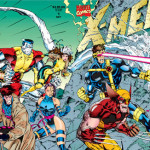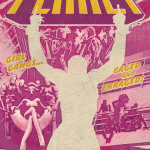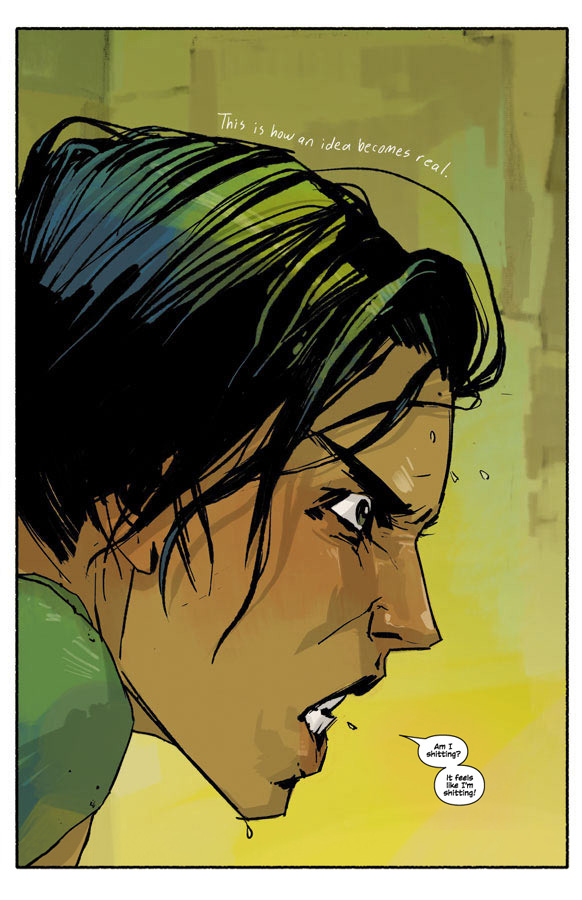It’s time for another Storify Post! This one is on comics & books industries, with a compare & contrast on digital strategy, overall vision, etc.

It’s time for another Storify Post! This one is on comics & books industries, with a compare & contrast on digital strategy, overall vision, etc.
Over lunch, I tweeted out a handful of short comics reviews from recent books I’ve read. Here’s a Storify of those reviews, and some links below to help find the books:
So, if Twitter and online media reviews are any indications, Daredevil is a hit. (I’m really liking it, though I’m only 9 episodes in).
We’re already in the middle of a wave of superhero TV, much of which is far better than has been made in the past.
But what’s next? Supergirl is coming, as is DC’s All-Star Team-Up (or whatever the series with ATOM/Firestorm and co. will be called).
The big Q I have right now is what superhero TV shows will be greenlit on the back of Daredevil‘s success.
What I’m hoping is that we see more supers shows developed with high production values without always already having to be gritty and morally gray. Agents of SHIELD got stronger after a weak launch, but when comparing it to The Flash or Daredevil, it’s now weak sauce.
Here are some ideas that took basically no time to come up with:
Birds of Prey (Pitch: Girls + crime-fighting) – Batgirl and Black Canary + 1-2 other 20-something women being young and fabulous and flawed and friends while fighting crime. You could basically work directly from the Stewart/Fletcher/Tarr Batgirl run for the first season as your starting point (after adjusting the plot of Issue #37).
The Unbeatable Squirrel-Girl (Pitch: No, seriously, this will work) – Here’s part one of Marvel’s play for tween/teen audiences. The new comics run is fun, whacky, and really kid-friendly. Do it as a cartoon if you need to. Avatar: the Last Airbender has proven that cartoons can have tonal range and work across demographic categories.
Ms. Marvel (Pitch: This book is huge, just make it) — This comic is a gigantic hit barely a year into its first run. Capitalize on this sensation while you’ve got it, Marvel. Take a stand by putting a Pakistani-American young woman front-and-center in the MCU. The success of shows like Jane The Virgin and Scandal prove that a woman of color in a lead can succeed in ratings. Though I get maybe wanting to wait with her to introduce Captain Marvel first in the MCU. Doesn’t mean you couldn’t do a 616 series instead of MCU, especially in cartoon form.
Silver Surfer (Pitch: It’s an American Dr. Who) – Take your cues from the current Slott/Allred run and have a ball. Made more difficult by the shiny silver-ness of the lead, but worth considering.
She-Hulk – (Pitch: It’s Ally McBeal for the 20-teens. OR It’s feminist superpowered Law + Order). Take your cues from the recent runs and go for a procedural show where the lead is both Law + Order by herself. Cast a statuesque actress or CG her up in post-production (the former is a smarter idea) and go for episodic plots – A plot is the legal case of the week, B-plot is a superhero plot. The next week, reverse it so the supers plot is the A-plot. And then use subplots in mini and maxi-arcs to give the whole show shape.
Wonder Woman (Pitch: The West Wing + Greek Gods). This has been tried for TV, but not in the way I think would work best. Let Wonder Woman be a Big Damn Hero and an international diplomatic figure. She’s a Big Deal. Draws inspiration from the Greg Rucka run on the character, maybe mix that in with the Greek God-tastic Azzarello run.
X-Men (Pitch: It’s a CW Show. With the X-Men). HOW IS THIS NOT ALREADY HAPPENING? CW is doing a lot of SFF, and an X-Men show focusing on younger heroes, a mix of existing and brand-new mutants, with some familiar faces on faculty, WOULD ROCK. To answer my own question, I imagine this hasn’t happened mostly because of Fox and Marvel’s strained relationship, but there’s money being left on the table here, folks. Looking at shows like The Flash, I think the tech is there to start putting more visually-impressive supers on TV. The look of many visually-distinct mutants can be achieved with good makeup.
What supers shows do you want to see, and how would you do it?
Here’s some stuff I’ve enjoyed recently that I’d like to share:
The Unbreakable Kimmy Schmidt – A Netflix original series from the team that created 30 Rock. The show follows Kimmy Schmidt, tricked into joining an apocalypse cult living underground for fifteen years before she and the three other women with her were rescued. But rather than living in victim-hood and work the talk show circuit, Kimmy decides to stay in NYC and start over.
The lead, Ellie Kemper, is the #1 reason to watch the show, IMO. The show takes a tragic character backstory and turns it into the reason for a comedy show. Kimmy is aggressively optimistic, even though the trauma of what was done to her is far from just washed away once the show starts. The show has some questionable representation that isn’t sitting well with me, but if you liked 30 Rock, this show is definitely worth a try.
Silver Surfer: New Dawn (Dan Slott, Michael Allred, Laura Allred, VC’s Clayton Cowles)
I have a soft spot for Silver Surfer ever since I read one of the old hardcover collections with his first solo issue appearances from 1968). The character is often shown as kind of flat, the brooding Herald of Galactus. But when well-done, the character is thoughtful and kind. The Slott/Allred Silver Surfer was, for me, a major return to form, clearly influenced by the original Kirby/Lee run. I wouldn’t have thought to tap Michael Allred to echo Jack Kirby’s cosmic baroque art, but it is a great fit. The story is solid, largely for that invocation of the late-60s run.
Blades in the Dark (John Harper)
Blades in the Dark is a Tabletop RPG being Kickstarted right now. It’s funded to the tune of over $50,000, and has a month left to go. Expect major stretch goal action.
The core game does the focused indie RPG thing of presenting a single core premise and game mode – in this case, playing a group of thieves who work together from nothing to build their criminal empire in a setting reminiscent of Video Game RPG Dishonored. The game invokes Fafhrd and the Grey Mouser and The Lies of Locke Lamora as comparisons, and it looks like it’d also play well for fans of Among Thieves.
I think this looks really cool, so I’ve backed it, and I figured that I’d share it in case other folks were interested. I haven’t gotten to play any tabletop RPGs in a while, but I like to keep an eye on what’s going on in the form and support interesting projects. Of particular note to me are the ‘build your missions’ idea that looks like it may solve the Shadowrun problem of ‘plan the job for 3 hours, then another 3 hours of combat.’
The completed stretch goals have added extra character archetypes and several all-new game modes (play the City Watch, play fantasy-whale hunters, play a group trying to overthrow the Immortal Emperor, etc.)

This gallery contains 5 photos.
Last week on Twitter, Comics creator Jim Zub (who is awesome, btw – go read his SkullKickers or his Japanese contemporary fantasy Wayward) called for creators and comics fans to share #FourComics that influenced them growing up. I shared my four on the hashtag, … Continue reading

This gallery contains 4 photos.
After attending Baltimore Comic-Con, I’ve drastically increased my comics consumption because 1) I love comics and 2) I’m keeping abreast of what’s going on in the industry, since 3) I’m getting into writing comics. I talk about what I’m reading a … Continue reading
As part of my move into comics writing, I’ve been reading tons of comics, largely assisted by a giant haul from NYCC.
Here’s a few comics I’ve read recently and enjoyed.
I have survived yet another New York Comic Con. The biggest ever, by current reporting.
This year, I had an extra mission, a driving interest behind my presence, thanks to my decision to get into comics writing.
Most years, I graze the fields of NYCC, drinking in the geekdom and following the tides of my interests.
This year, I spent a *lot* more time in Artists’ Alley, talking with creators, making acquaintances and friends. If I’m going to work in the comics community, I need to be a *part* of the comics community, and in a much greater way than I have been happily reading on my own and talking with people about it intermittently.
Which means that I came back from the con with my suitcase *completely full* of comics. And a few clothes, I guess. Mostly comics.
I had several really cool conversations with creators, and got to hang out a lot more with some folks I’d met at cons earlier in the year. It’s an odd thing to be operating in a new professional world, where I don’t recognize people by sight like I do in SF/F prose.
Here’s a quick round-up of some of the swag I acquired during my trip. It…was a lot. My bank account took a not-insubstantial hit thanks to my love of Cool Stuff.
And…more where that came from. I may have gone a little overboard. I also bought some art, which I will show off in a separate post.
A couple of weeks back, I attended my first Baltimore Comic-Con. It clocked in at around 15,000 people, and unlike the bigger Comic-Cons (NYCC or PHXCC) that I’ve attended, Baltimore was still very much focused on comics.
After two days of panels, browsing, meeting creators, and loading my bags down with glorious comics goodness, I should have expected this to happen.
Sometime during the weekend, I was bitten by a radioactive comics bug. It re-awakened my often-deferred interest in writing for the form.
I grew up reading comics, taking the change from our recycling deposits down to the friendly local comic shop in Brooklyn to buy the latest issue of Spider-Man, Batman, or X-Men. I’ve tried my hand at writing comics scripts only a little bit, but often thought about what it’d take to move into that form.
Now, let me be clear that I have no intentions of leaving prose writing. That’s my home base, and I’m not likely to ever stop writing prose. But more and more, I see writers crossing formats, including several of my writing idols (Neil Gaiman, China Mieville, Greg Rucka, among others).
Therefore, the last couple of weeks, I’ve been devouring comics, deepening my immersion in the form, investigating what’s going on at the top of the form with the works that are making waves and pushing at the edges of what the form can and is doing.
Here’s a representative sample of my research list:
I’ve also been diving into some craft books, and revisiting some others I’ve already read:
Lessons learned so far
Transcribe
One of the best things I did in trying to deepen my understanding of the differences between writing prose and writing for comics was to open my copy of Saga Vol. 1 and transcribe the finished comic back into a script, trying to capture the visuals, emotion, and to see how much text fit on the page.

Saga, Issue #1 page 1. From Image Comics. (C) Brian K. Vaughn and Fiona Staples
Script != Finished Page != Script
The biggest challenge I’ve faced so far coming to comics writing is that the finished product is drastically different from the working document that a comics writer will produce. When learning prose writing, you can look at a piece of fiction and see the final draft as the actual product. But in comics, there’s so much of a collaboration and melding of the styles and skills of several creators (sometimes as many as six: writer, penciler, inker, colorist, letterer, editor, graphic designer) that a writer’s script is only one part of the equation. For me, that makes it harder to tease out where my part is, especially writing without having yet found any collaborators. I want to write some scripts and see how well my novelist chops translate before trying to make finished comics, and then start reaching out when I’m confident that I’ve learned the comics form well enough to start making professional works.
Basically, It’s Writer Multi-Classing
I’ve written seven novels (two of which are trunked, never to be seen again), and a long novella, as well as a couple dozen short stories. In D&D terms, I’m somewhere in the 3-5th level in terms of my Prose Writer class. But this, this is taking a new class – Comics Writer. There are different skills, different class abilities, and a whole power tree of collaboration powers for when you’re in a party with other comics creators. So while my overall Writer level combines my Prose Writer and Comics Writer levels (like a Wizard taking a level of a prestige class), my Comics Writer level is still 1 right now, so there’s a weird feeling of starting over, of going back to square one. I know a lot about storytelling, but the format, the medium is very different, and I’m having to learn to adjust to it, just like I adjusted from storytelling in RPGs to storytelling in prose.
Choosing Your Moment
Since the comics form is one where moments (panels) are compressed into a fluid narrative experience by the reader, one of the most important tasks for a creator is to chose your moments, to pick which snapshot in the action to depict in a panel, as well as how to space out your moments – several panels showing moments very close together, or jumping farther in time between panels. This is not unlike the task of scene selection in prose writing, or picking where to dramatize within a scene, but it’s very much its own thing in comics.
The Business End
I work in SF/F prose publishing. I’ve been learning about the trade publishing industry, and SF/F prose publishing in specific, for around a decade. It has certain processes, customs, and paths to publication.
Comics, unsurprisingly, is different. I’ve asked questions about submission and breaking in to creators and publisher staffers at the various comic-cons I’ve attended, and I’ve received incredibly divergent answers.
Here’s how to break in, as I’ve been told:
As you might be able to tell, that’s a fair range. The fact that I have several novels out from traditional publishers changes the game for me somewhat, but it doesn’t give me one clear path to publication. In prose publishing, you can query agents, who then pitch to editors. There are other paths as well, but this is the ‘standard’ path. Comics doesn’t seem to have as clear a ‘standard’ path to publication. (Note that the standard path in prose publishing is often anything but easy. But it is the default, one that takes an unpublished debut work and then gets it sold to a publisher).
As you’ll note, this post says ‘Part One.’ I’ll keep talking about my experiences moving into comics writing, both to remember what the process was like, and to (hopefully) cast some light on the journey for other writers interested in moving into comics, either from a prose background or not.
I will be attending the Phoenix Comic Con this week, working the Angry Robot Books booth and appearing as an author. I’ve been to New York Comic-Con twice, and I love seeing and participating in these huge celebrations of popular culture.
Aside from basking in the geekitude, here’s where you can find me:
Friday
Angry Robot Preview Panel – 12:00-1:00, North 128a
Urban Fantasy and the Real World – 1:30-2:30, North 126bc
Saturday
Drinks With Authors – 8-11PM, Renaissance Salon 5-8
And the rest of the con, I’ll mostly be at the Angry Robot Booth, #2410-2412.